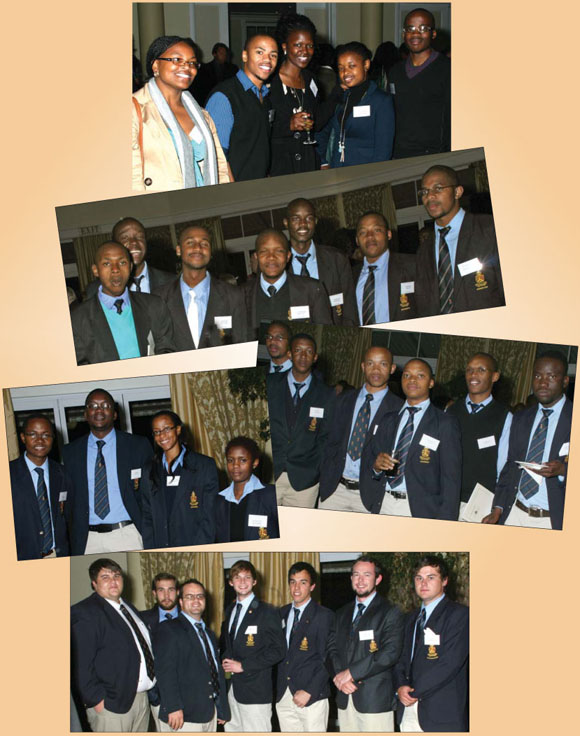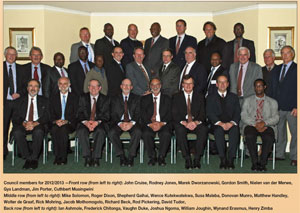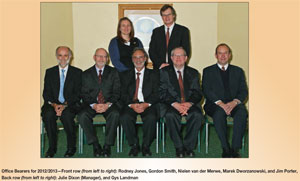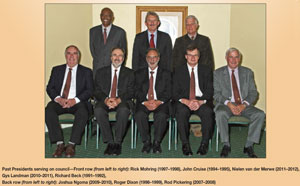Services on Demand
Article
Indicators
Related links
-
 Cited by Google
Cited by Google -
 Similars in Google
Similars in Google
Share
Journal of the Southern African Institute of Mining and Metallurgy
On-line version ISSN 2411-9717
Print version ISSN 2225-6253
J. S. Afr. Inst. Min. Metall. vol.112 n.9 Johannesburg Jan. 2012
Proceedings 115th Annual General Meeting, 2012
The 115th Annual General Meeting of The Southern African Institute of Mining and Metallurgy was held at The Country Club, Johannesburg, Napier Road, Auckland Park on Wednesday, 15 August 2012.
Welcome
The President extended a special welcome to the guests and representatives of our sister institutes and other associations, and also to recipients of awards, senior members of industry, Honorary Life Fellows, past-presidents, our members, and other guests, among them the following:
M. Cresswell, President, South African Coal Processing Society
A. Hoffman, Vice President, South African Institute of Electrical Engineers
O. Letsholo, Immediate Past President, Institute of Certified Mechanical and Electrical Engineers, South African
P. Naidoo, President, The Geological Society of South Africa (GSSA)
M. Nzimande, President, Association of Mine Managers South Africa
B. Sibiya, Chief Executive Officer, Chamber of Mines of South Africa
J. van Zyl Visser, Institute of Mine Surveyors of South Africa
Past-presidents attending
Alfred Brown Joshua Ngoma
Richard Beck Rod Pickering
John Cruise Rams Ramokgopa
Roger Dixon Dick Stacey
Andrie Garbers-Craig Oskar Steffen
Rick Mohring
Minutes
The minutes of the previous Annual General Meeting, which were published in the September 2011 issue of the Journal, and sent to all members, were confirmed.
Obituaries
The President announced the death, during the year, of the following members:
Life Fellow
C.T. Shaw
Fellow
G. Annandale
Retired Fellows
D.W. Moffat, G. Maude, D.J. Mulligan, J.A. Tyser, R.J. Whyte, P.M.T. White
Members
P. Gericke, J.M.A. Geldhuis, M.N. Carter, S.J.J. van Heerden Associates
L.G. Waller, M.J. Khoase
In memory of the deceased and in sympathy with the bereaved, all rose and observed a moment of silence.
Honorary Fellowship
No award was made this year.
Brigadier Stokes Memorial Award
Rodney Jones: The Brigadier Stokes Memorial Award was instituted in 1980 to commemorate the outstanding contribution to the South African mining industry made by Brigadier R.S.G. Stokes, an Honorary Life Fellow and past-president of this Institute. The award is made to an individual for the very highest achievement in the South African mining and metallurgical industry. It gives me great pleasure to announce that the award for 2012 is to be made to Richard Peter Mohring.
Rodney Jones called upon John Cruise, to read the citation: Publically it is an honour, and privately it gives me great pleasure to present the citation for my old friend and colleague Rick Mohring. Born in Johannesburg in 1947 and receiving his formative education at the King Edward VII School, also inJohannesburg, Richard Peter Mohring was surrounded by mine dumps. It must have been during these formative years that mining crept into his blood, because on matriculating from school he enrolled at the University of the Witwatersrand to read for a Bachelor's degree in Mining Engineering. This degree was conferred on him in 1972. It must also have been in these formative years that Richard Peter Mohring became known to his family and classmates as Rick, and it is by this moniker that he is known to us all todayhis friends and colleagues. Researching through the back issues of the SAIMM Journal, I record that even in the official publication of his presidential year of 1997/1998, he is referred to as Rick. And so, with apologies to his parents, I will stick with Rick.
Rick is recognized today, not only because of his service to the Southern African Institute of Mining and Metallurgy, which in itself has been substantial, but also his dedicated service to the Engineering Council of South Africa and his contribution to the changing face of coal mining in South Africa.
On graduation, Rick started life on the mines as a graduate learner on Durban Roodepoort Deep gold mine, where he progressed through the ranks of Shift Boss, Mine Overseer, and Underground Manager before being transferred to the Rand Mines coal division in 1975. Thus, after the solid grounding of basic training on deep-level gold mines that graduates were subjected to in those days, Rick began his illustrious career in coal mining. Before 1975, coal mining was the poor cousin of the rich gold mines. But that was soon to change, and Rick was intimately involved in the quantum leaps that coal mining in South Africa took in the following years. From 1975 to 1981, Rick was the Planning Manager for Duvha Opencast which along with Rietspruit was the first opencast coal mine within the Rand Mines group. Without any previous exposure to dragline stripping methods and with the very limited computer-based systems that were available at that time, he designed and executed a project for a 12 million ton per annum coal mine.
In 1980 Rick attended the MDP programme at the University of South Africa, where he was its Gold Medal winner.
In 1981, at the age of 34, Rick was appointed as the General Manager of Welgedacht Exploration Company, which consisted of three operating minesUtrecht, which was a low-seam hands loading anthracite mine Umgala, a high-seam bituminous mine which was totally extracted by stooping (I leave it to the metallurgists amongst you as to what the term stooping refers to in coal mininga clue is that it is not being bent double all the time one is underground) utilizing drill and blast methods and also continuous miners; and Zimbutu, a mechanized underground mine. This was followed a year later with his appointment as General Manager of Middelburg Mine Services. He was responsible for not only project planning and commissioning of a 10 million ton per annum coal mine, but also for running the mine that he had designed. This is probably the most practical experience that a young mining engineer can gain, and it stood Rick in good stead for his later achievements.
In 1984 Rick attended the PDM Programme at Harvard University.
Also in 1984, Rick was appointed as a Managing Director of Rand Coal, a position he held for the next decade. During this time he was responsible for the management of various mines within the Rand Coal group and was on the boards of directors of various wholly-owned subsidiaries of Rand Coal. He was responsible for the development of the Khutala and Majuba collieries. Khutala utilized high-capacity continuous miners capable of producing one million tons of coal per section per annum. It had a single coal clearance shaft which produced 12 million tons per annum.
Coal mining was now outstripping gold mining in mechanization and innovation. Coal mining was no longer the poor cousin.
In this decade, Rick was responsible for the successful combining of a large export colliery (Middelburg, at 8 million tons per annum) with an Eskom supply colliery (Duvha, at 10 million tons per annum) into a single operating unit, including the installation of a railway line between the properties. He also successfully renegotiated the coal supply contract with Eskom. He initiated the planning and development of Majuba Colliery, which at a depth of 300 metres was deep for a South African colliery.
An interesting feature of this period that has relevance today, is that Rick conducted 'coal-bed methane drainage tests' on this very gassy coal field. As he knew my interests lay in explosives and esoteric blasting, Rick confided in me that he was 'fracking' the coal. At first I thought that Rick was swearing and I was shocked. I told him that the term would never come into popular parlance and certainly never be used around the fine dining tables of Johannesburg society. Remember this was some twenty years ago. Well, in hindsight, how wrong can you be! Although I must say that many people in the Johannesburg high society today do consider it a swearword when applied to the Karroo.
During the next decade, from 1994 to 2003, Rick was in quick succession the Senior Operations Manager of Ingwe Coal Corporation, the Chief Executive Officer of NewCoal, and the Deputy Chief Executive Officer of Eyesizwe Coal. This was the time of change and transformation in South Africa, much of it being led by the mining industry. At Ingwe Coal, Rick installed the largest shortwall in South Africa and the highest in the world, with 6 metre high supports, at Matla colliery. NewCoal was a black empowerment initiative set up by AngloCoal and Ingwe Coal Corporation to identify a suitable Black Economic Empowerment (BEE) group to purchase certain assets belonging to the vendors and establish a new BEE company. After an 18 month process, the largest BEE coal company, Eyesizwe Coal, was formed in November, 2000. As the Deputy Chief Executive Officer, Rick was responsible for overseeing and mentoring of the whole transformation process.
Since retiring in 2003, Rick has set up his own mining consulting company and is a non-executive Board Member of Exxaro Resources Ltd. Among the many Exxaro committees that he stands on, Rick is the Chairman of the Exxaro Transformation and Remuneration Committee. Thus, since 1975, Rick has been at the forefront of successful development and transformation of the coal mining industry, not only in technical terms but also political.
Outside of his direct work as a professional mining engineer, Rick has been associated with the Engineering Council of South Africa (ECSA) for many years. He served as a Council Member from 1992 to 2008. He has been the Past Chairman of the Professional Advisory of Committee for Mining Engineers, the Past Chairman of the Registration Committee for Professional Engineers, and the Past Chairman of the Central Registration Committee for Engineering. He chaired the subcommittee that developed the policy and rules for Continuing Professional Development. He is a member of the Identification of Engineering Work subcommittee and a member of the ECSA team that negotiates with the Council for the Built Environment. On the international front, Rick was a member of the committee that represented ECSA in the negotiations for acceptance in the Washington Accord and the Engineers Mobility Forum, which gave rise to the recognition of registered engineers throughout the world.
Rick's involvement with tertiary education is shown in that he has been a member of the ECSA University Accreditation Teams for Mining Engineering progammes at universities and universities of technology over many years. Recently, he was the Team Leader for the provisional accreditation of the University of Namibia and the Polytechnic of Namibia. Rick is a member of both the University of Pretoria Mining Advisory Board and the University of the Witwatersrand Mining Advisory Board.
Rick's involvement in associated industry associations is evident in the Fossil Fuel Foundation, the Chamber of Mines of South Africa, the International Committee for Coal Research, and the International Energy Agency. For the Fossil Fuel Foundation, Rick has been a Trustee and has organized and chaired a number of Coal Indaba conferences. For the Chamber of Mines of South Africa, Rick represented Rand Mines on the Collieries Committee, and latterly he conducted an Acid Test to ascertain the impact of draft regulations for the Identification of Engineering Work on the mining industry. For the International Committee for Coal Research, Rick was a member of the South African committee during the 1990s and was on the committee to advise on coal research, encourage international research collaboration, and inform industry on coal research projects. For the International Energy Agency (IEA), Rick represented South Africa from 2000 to 2003 on the Coal Industry Advisory Board, a subcommittee of the IEA based in Paris.
Finally, Rick's involvement with the SAIMM has been prolific. Rick has been a member of the SAIMM since 1971 and a Council Member since 1988. He is an Honorary Life Fellow and a Past President, having served his term in 1997/98. He is a Trustee of the SAIMM Scholarship Fund. Needless to say, he has served on many committeesTPC mining, book publications, and membership amongst others. He tells me that his favourite committees were the Scrutineers Committee and the Banquet Committee. The only common factor that I can discern is that the Scrutineers' meeting was followed by lunch and the Banquet was preceeded by a lunch, of banquet food and wine tasting.
Rick has said to me that he feels that he has been lucky to be in the right place at the right time. But luck is not everything. As Gary Player once said: 'The harder I practice, the luckier I get'.
Richard Peter Mohring embodies all that SAIMM motto states. Our motto is 'Capaci occasio', which directly translates as 'To the capable, the opportunity', or as I prefer 'Give to he who is capable, the opportunity to do'.
Rick Mohring:
Mr President, members, ladies and gentlemen, Lyn, Lucinda, and Mark, good afternoon
I feel greatly honoured that you have awarded me this prestigious prize and accept it with great humility.
Thank you John for the kind words, but I must admit that most of what I achieved was by being in the right place at the right time and being associated with some fine people. Getting a prestigious award for a career which gave me great satisfaction and which I thoroughly enjoyed, is indeed a bonus.
When I reflect on my many years in the industry my career had two distinct components:
*the corporate employee role
*involvement with outside bodies.
In the mid-1970s, while I was a young underground manager on the gold mines, doyens of the coal industry like Allan Sealey and Graham Boustred were hatching plans for the development of a large coal export industry and new mines to assist Eskom in modernizing their generation capacity.
This created the need for the development of many new large-scale coal mines and I was fortunate to be given the opportunity to be part of this massive growth in coal mining in South Africa, being involved in the successful planning and execution of the many projects mentioned by John, and the unfamiliar fields at that time of international coal logistics and marketing.
Development of these mines also created the opportunity to employ the latest technology and mining methods, which involved interaction with number of international mining and manufacturing companies.
The success of the projects was by no small means due to the enthusiasm, drive, and skill of the people for whom I worked and those who worked for me.
One of the highlights was when I was given the opportunity to create, through a very extensive tendering process, a new Black Empowerment coal company with assets provided by Anglo Coal and Ingwe. This was a fascinating and rewarding initiative which brought me into contact with a diverse range of people-bankers, lawyers, and aspirant coal minersmany of whom had no experience in mining, and it proved that transformation can work. Mr Sipho Nkosi and his team have taken Eyesizwe Coal, which has since merged with the non-iron assets of Kumba, from the largest black-owned company to a JSE top 40 diversified miner and it is still growing.
My involvement with organizations outside my direct working environment started with becoming a member of the SAIMM during my student days. I got more directly involved when my boss and mentor, Allen Cook at Rand Mines Head Office, encouraged employees to get involved with both industry and professional bodies.
This was the start of my involvement at the Chamber of Mines and the Institute, and it was this involvement with the SAIMM that led to me having a long and varied engagement with the Engineering Council of South Africa, as it is the SAIMM who nominate representatives to the various registration bodies and to Council.
Similarly, my involvement with the Fossil Fuel Foundation, International Committee on Coal Research and the International Energy Agency had their roots in contacts made through Institute activities. My thanks go to all the wonderful peopletoo many to mention individuallythat I met through my association with these bodies for sharing their wisdom with me.
While one appreciates that companies are cutting back on the time allocated to staff to carry out non-company business, the value of the networking and information transfer that this Institute and other similar bodies offers is of great value, both to the individuals and the company for whom they work, and I encourage those who are involved to stay involvedand those who are not yet involved to offer their services. The combined wealth of your experience and wisdom must be used to the benefit of the industry and the growth of our national economy.
I would like to acknowledge the valuable work of this Institute, and encourage members to ensure that it maintains its status as the leader in professional and technical matters relating to mining and metallurgy.
In receiving this award I would like to acknowledge the support of Lyn and my family in my career.
In conclusion, Mr President, having reflected on the names of previous recipients, I am extremely grateful to you and the Council for the honour that you have bestowed on me, something I will always cherish, and I wish the Institute everything of the best for the future.
Thank you.
Presentation of awards, medals, and certificates
Rodney Jones announced the following awards, medals, and certificates, which were presented by Nielen van derMerwe.
50-year Membership Awards
(with effect from 1 July 1961 to 30 June 1962)
► W.B. Evans
► R.A. Featherstone
► I.R.H. Forrest
► J.S. Freer
► B.W. Holtshousen
► B.J. Love
► G.S. Lee
► P.J. Muller
► G.J.C. Young
► W.J.G. Young
Gold and Silver Medals
Papers published in the Journal from March 2011 to February 2012 by members of the Institute were considered for medals.
Gold Medals
Gold medals are awarded for papers that are of a world-class standard, and judged to be publications that will become key references in their mining or metallurgy field in the future.
Gold Medals were awarded to:
W.C. Joughin, A. Jager, E. Nezomba, and L. Rwodzi, for their Transaction paper published in the February 2012 issue of the Journal entitled 'A risk evaluation model for support design in Bushveld Complex underground mines: Part I Description of the model' and 'Part IIModel validation and case studies'. As non-members A. Jager and E. Nezomba receive a certificate of merit.
Silver Medals
Silver medals are awarded for papers that make a major contribution to the professions of mining and metallurgy and to the prestige of the Institute. Silver Medals were awarded to:
J.A.L Napier and D.F. Malan, for their Transaction paper published in the December 2011 issue of the Journal entitled 'Numerical computation of average pillar stress and implications for pillar design'.
Presentation of Student Prizes
Rodney Jones announced the student winners of the SAIMM Prestige Prize and Nielen van derMerwe presented the awards to the students adjudged by their departments to be the best final-year students in 2011.
University of the Witwatersrand
Mining Zacharia Maruma
Metallurgy Thapelo Montong
Best final-year student in the
faculty of any engineering
discipline (chemical) Ashley Gritzman
Best final-year student in any
faculty in the discipline of
mining or metallurgy Zireena Khan
University of Pretoria
Mining Stephanie Ferrreira
Metallurgy Morne Grewar
Student dissertation Stephanie Ferrreira
University of Johannesburg
Mining Sifiso Mashile
Metallurgy Palesa Mphuthi
North-west University
Mineral Processing Herman Kemp
The following SAIMM student prizes were presented at the Western Cape Branch AGM on 1 August 2012.
University of Cape Town
Best final-year student
Mineral Processing (Joint Prize) David Vogel and
Mesuli Zondo
University of Stellenbosch
Best final-year student
Mineral Processing Henri Cloete
Cape Peninsula University of Technology
Best final-year student
Mineral Processing Dineo Innocentia Kadi
Annual Report and Accounts
The Honorary Treasurer, Jim Porfer.presented the financial statements.
The message behind this year's financial report has to be your Institute's successful on-going efforts to promote, invest in, and develop our activities throughout southern
Africa. At the same time, the Institute has worked to contain the cost of your membership and attendance of conferences, etc. in an increasingly stressed economic environment for the local mining industry.
At the beginning of the 2012 year, with the approval of Council, Office Bearers introduced a set of defined projects as part of the operating budget. The objective was to create visibility of these activities to Council throughout the year and to better manage the funding of these projects. As mentioned in my report last year, funding was to be through the use of our accumulated AFC Investment Portfolio. A further decision, made early in the year as a matter of policy, was not to cut back on the quality of events run by the Institute. These two decisions were key drivers in terms of our financial results for the year.
Of technical note: wording and style used in the audited financial statements for 2012 is different to our historic reporting standard. This is as a result of your Institute's Auditor complying with modern accounting practice. There is no impact on the reporting of historical and comparative numbers.
To get to the numbers; in my report last year I stated: 'At this point I think that it is prudent to caution our members that the performance of last year is not likely to be repeated.'
Whilst the 2010 to 2011 financial year saw a set of record financial results, the 2012 financial year has required close management by the SAIMM staff as Office Bearers worked to achieve the President's plans for the year.
I am pleased to report that we have, for the most part, been modestly successful.
Key metrics for the year relative to 2011 are as follows:
► Assets: R26 695 874 (down 1.5 per cent)
► Equity: R25 313 164 (up 0.9 per cent)
► Liabilities: R1 381 710 (down 32 per cent)
► Revenue: R16 441 264 (down 19 per cent)
► Cost of sales: R12 242 795 (down 14 per cent)
► Operating expense: R7 752 819 (up 60 per cent)
► Operating surplus: (R2 197 227) (down 196 per cent)
► Total surplus: R46 710 (down 99 per cent).
Clearly, some comment is required on the salient changes in performance relative to last year:
► Assets: The SAIMM has been carrying a cumulative loan of R636 882 to the Scholarship Trust Fund. We have now converted this to a donation. The effect of this change on Total Assets was 2.3 per cent year-on-year.
► Liabilities: This reflects better management of creditors.
► Revenue: A drop of R3.8 million was mostly due to the smaller number of 'headline' conferencing events in the year. To quote once more from last year's report:
'The reasons are that there are not as many large events in the year ahead
► Cost of sales: This was managed down relative to the number of conference events. Included is our expenditure for Branch travel of R746 000 which has increased year-on-year by 67.6 per cent due increased activity within SADEC.
► Operating expenses: This year the following extraordinary expenses were included:
- R438 000 in management fees
- R281 000 AFC management fees
- R1 015 000 in donations
- R151 000 sale of assets
- R153 000 OneMine subscription.
Without these items the annual increase would have been 8.6 per centslightly above inflation.
The balance sheet shows that non-current assets rose by 1.6 per cent to R19 091 526 (R18 790 093). Growth is largely as a result of our investment activities growing by 5.1 per cent to R18 933 627 after drawing down R1.0 million to fund these projects:
► SCI Bono: R250 000
► Wits Mine Planning: R400 000
► SAIMM Office: R293 000
► Branch travel: R746 000.
It is also worthwhile noting that the total investment growth is made up of:
► Fair value adjustment: R1 456 608
► Interest: R787 329.
The net result of maintaining growth projects with constrained income is a surplus of just R46 710, including the modest growth of 5.1 per cent in our investments.
One of the major efforts undertaken to maintain a healthy bank and call account of R6.198 million, was the strict control of debtor accounts to within 60 days overdue. This policy has paid off and significantly impacted on the financial well-being of the Institute. At year end our debtor's position stood at some 6 per centa historical record low.
So, it would seem that the guiding philosophy for our 2012/13 financial year will be 'SEMPER CENSUM NE SUPERET' (Google it!!).
Office bearers and Members of Council for 2012/2013
Nielen van derMerwe announced the office bearers for the ensuing year, elected by the retiring Council in accordance with Clauses 3.2 and 3.3 of the Constitution:
President G.L. S mith
President-elect M. Dworzanowski
Senior vice-president J.L. Porter
Junior vice-president R.T. Jones
Immediate past-president J.N. van der Merwe
Honorary treasurer J.L. Porter
In terms of the election of ordinary members of Council (bylaw 3.2.7), there were fourteen vacancies and the following members are now declared elected (in alphabetical order):
H. Bartlett D.D. Munro
N.G.C. Blackham C. Musingwini
V.G. Duke S. Ndlovu
M.F. Handley M.H. Solomon
W.C. Joughin A.G. Smith
A.S. Macfarlane D. Tudor
M.J. Mothomogolo D.J. van Niekerk
In terms of Clause 3.2.11 of the Constitution, the chairmen of the branches are as follows:
DRC Susa Maleba
Johannesburg Ian Ashmole
Namibia Frederick Chitonga
Pretoria W. De Graaf
Western Cape J. Petersen
Zambia S. Mulenga
Zimbabwe Shepherd Gaihai
Zululand W. Erasmus
These chairmen will be ex-officio members of Council.
The following past-presidents have signified their willingness to serve on Council for the ensuing year:
R.D. Beck S.J. Ramokgopa
J.A. Cruise T.R. Stacey
N.A. Barcza F.M.G. Egerton
R.P. Mohring W.H. van Niekerk
J.R. Dixon R.G.B. Pickering
M.H. Rogers A.M. Garbers-Craig
Gys Landman thanked those past-presidents who indicated that they cannot serve on Council for the next year for all their time, effort, and dedication in the past.
He also thanked past-presidents for their continued support. He congratulated all those elected, and thanked those who agreed to serve another term of office.
Election of auditors and honorary legal advisers for 2012/2013
Nielen van derMerwe proposed and it was agreed, that R.H. Kitching be reappointed as Auditor for the coming year and that Van Hulsteyn, Attorneys, be reappointed as honorary legal advisers.
Induction of President
Nielen van der Merwe introduced the new President, G.L. Smith, and then called upon Rodney Jones to read his curriculum vitae.
Gordon commenced his mining career in 1979 as a learner miner with Rio Tinto Zimbabwe at Empress Nickel Mine. On completion of his learnership he attended the Bulawayo School of Mines, obtaining a technicians diploma in mining before commencing studies, at the age of 23, at the University of the Witwatersrand for a BSc Engineering (Mining) in 1981. Following graduation in 1984 he was assigned to Renco Gold Mine in Zimbabwe and progressed rapidly through a variety of production positions before moving to the Falcon Mines plc Group as Group Projects Officer in 1986. During his subsequent tenure as Underground Manager, Mine Superintendent, and Group Technical Adviser he was instrumental in the introduction of a variety of new operating procedures, mining layouts, and technologies to the Falcon Mines operations in Zimbabwe.
Gordon emigrated to South Africa in 1989 and joined COMRO (Chamber of Mines Research Organisation) as a Principal Engineer in the Stoping Technology Laboratory. In this role he was involved in the development of new mining technologies in the fields of rockbreaking and rock handling. In 1992 he completed an MSc Engineering at Wits, based on the development of an economic model for the evaluation of new mining technologies. In 1993, following the formation of the CSIR Division of Mining Technology from COMRO, he was involved in rock engineering research (deep-level remnant extraction techniques), and later was tasked with the establishment of their Rock Engineering Consultancy Services. In 1995 he completed a part-time MBA, also at Wits, and undertook subsequent roles as Manager: Marketing and Business Development, and Programme Manager: Environmental Safety and Health, before accepting the position of Manager: International Business Development in April 1998. In late 1998, following the structuring of the Snowden Mining Industry Consultants international joint venture, he was appointed as Managing Director and Consultant Mining Engineer of Snowden-Africa.
In 2001 Gordon co-established an independent mining company, Metallon Mineral Resources, with the objective of developing medium-scale diamond, tantalite, and gold mining operations in the southern African sub-region. Control of Metallon and its associated subsidiaries passed to an empowerment group in 2003 and Gordon moved to Anglo American Platinum Limited in December 2003 in the capacity of Head: Strategic Long Term Planning. In 2009, following a reorganization of operations, he assumed responsibility as Head: Mineral Resource Management with accountability for Mining Technical Services, Business Planning, Strategic Long Term Planning, and Projects Coordination. In 2011 Gordon completed a PhD at Wits based on the strategic long-term planning processes, tools, and techniques he developed and implemented at Anglo American Platinum during his tenure as Head: Strategic Long Term Planning.
Gordon is a director of a number of companies, a registered Professional Engineer with the Engineering Council of South Africa, a Fellow of the Southern African Institute of Mining and Metallurgy, a Fellow of the Mine Ventilation Society of South Africa, and a member of the International Society for Rock Mechanics.
Having joined the SAIMM in 1983 as a student member, Gordon became a Member in 1990 and a Fellow in 1998. Since 1995 he has served in a number of capacities in the committee structures: as secretary and chair of the Johannesburg branch, as member and chair of the TPC mining and membership committees, and on the mining awards and publications committees. He was elected to Council in 2001 and became an office bearer in 2009. In 2007 he was elected to the ECSA professional advisory committee for mining. He also serves on the SAMREC and SAMVAL committees as an SAIMM representative.
Gordon is married to Wendy, whom he met at university, and they have a 25-year old son, Richard. Rest and recreation revolve around cooking and carpentry, weekend farming, fly-fishing, and travel.
Presidential Address
Gordon Smith then presented his presidential address entitled: Strategic long term planning in mining, which is reproduced elsewhere in this edition of the Journal.
Vote of thanks
Marek Dworzanowski, gave the vote of thanks.
Closure
The meeting closed at 18:00. ♦



50-year Membership Awards








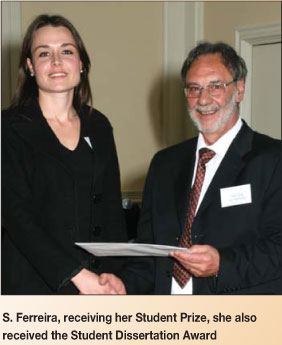
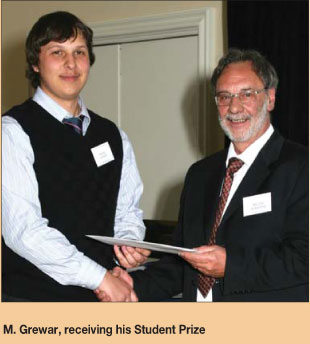
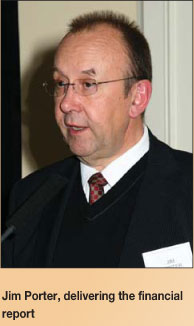
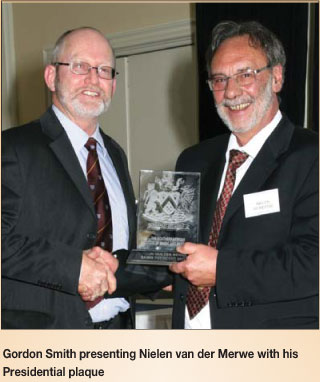
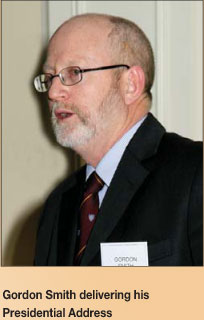
Council members and Branch Chairmen of the SAIMM
Office Bearers for 2012/2013
Past Presidents of the SAIMM
Members and their guests at the cocktail party
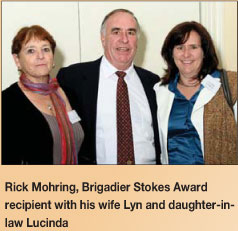
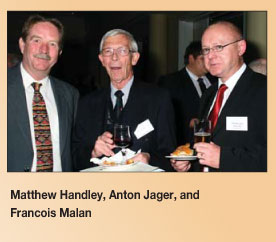
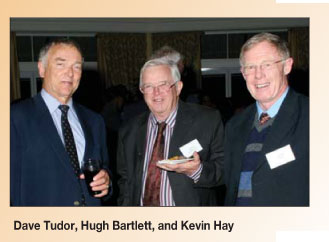
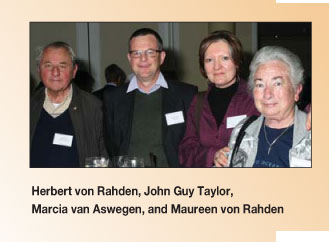
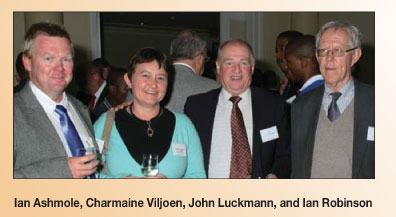
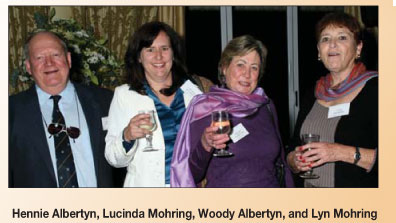
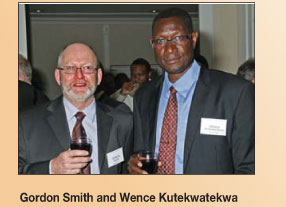
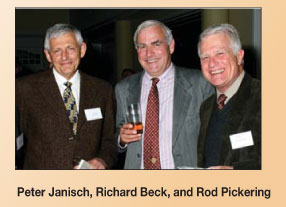
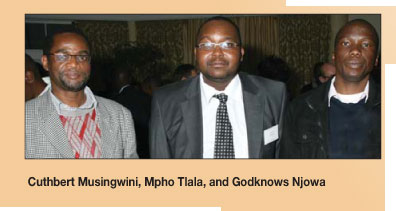
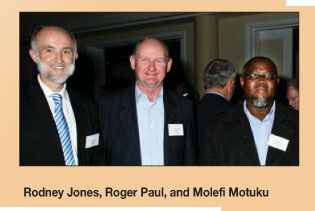
University students enjoying the cocktail party after the AQM
